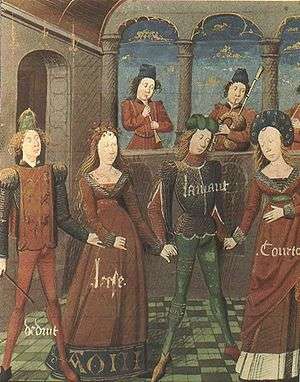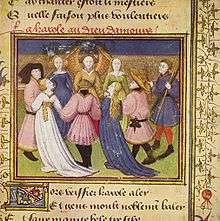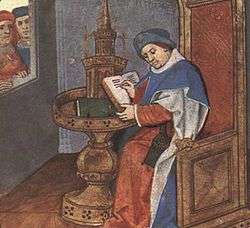Roman de la Rose

The Roman de la Rose (French: [ʁɔmɑ̃ də la ʁoz]; "Romance of the Rose"), is a medieval French poem styled as an allegorical dream vision. It is a notable instance of courtly literature. The work's stated purpose is to both entertain and to teach others about the Art of Love. At various times in the poem, the "Rose" of the title is seen as the name of the lady, and as a symbol of female sexuality in general. Likewise, the other characters' names function both as regular names and as abstractions illustrating the various factors that are involved in a love affair.
History
The poem was written in two stages. The first 4058 lines, written by Guillaume de Lorris circa 1230, describe the attempts of a courtier to woo his beloved. This part of the story is set in a walled garden or locus amoenus, one of the traditional topoi of epic and chivalric literature. Around 1275, Jean de Meun composed an additional 17,724 lines. In this enormous coda, allegorical personages (Reason, Genius, and so on) hold forth on love.
Reception

The work was both popular and controversial—one of the most widely read works in France for three centuries. Its emphasis on sensual language and imagery provoked attacks by Jean Gerson, Christine de Pizan and many other writers and moralists of the 14th and 15th centuries. Historian Johan Huizinga writes: "It is astonishing that the Church, which so rigorously repressed the slightest deviations from dogma of a speculative character, suffered the teaching of this breviary of the aristocracy (for the Roman de la Rose was nothing else) to be disseminated with impunity."[1]
Manuscripts and incunabula
.jpg)
About 300 manuscripts are extant,[2] one of the highest figures for a secular work. Many of these are illustrated, most with fewer than ten remaining illustrations, but there are a number with twenty or more illustrations,[3] and the exceptional Burgundian British Library Harley MS 4425 has 92 large and high quality miniatures, despite a date around 1500; the text was copied by hand from a printed edition. These are by the artist known as the Master of the Prayer Books of around 1500, commissioned by Count Engelbert II of Nassau[4] The peak period of production was the 14th century, but manuscript versions continued to be produced until the advent of printing, and indeed afterwards - there are at least seven manuscripts dated after 1500.[5] There are also seven incunabula printed editions before 1500, the first from Geneva in about 1481, followed by two from Lyons in the 1480s and four from Paris in the 1490s.[6] An edition from Lyons in 1503 is illustrated with 140 woodcuts.[7] Digital images of more than 140 of these manuscripts are available for study in the Roman de la Rose Digital Library.
Translation and influence
Part of the story was translated from its original Old French into Middle English as The Romaunt of the Rose, which had a great influence on English literature. Chaucer was familiar with the original French text, and a portion of the Middle English translation is thought to be his work. Critics suggest that the character of "La Vieille" acted as source material for Chaucer's Wife of Bath. There were several other early translations into languages including Middle Dutch (Heinrik van Aken, c. 1280). Il Fiore is a "reduction" of the poem into 232 Italian sonnets by a "ser Durante", sometimes thought to have been Dante, although this is generally thought unlikely. Dante never mentions the Roman, but is often said to have been highly conscious of it in his own work. In 1900, the pre-Raphaelite F. S. Ellis translated the whole of the poem into English verse. C. S. Lewis's 1936 study The Allegory of Love renewed interest in the poem.
Gallery
-

Miniature from a manuscript of the Roman de la Rose (Oxford, Bodleian Library, Douce 195), folio 1r, portrait of Guillaume de Lorris.
-
_The_Godess_of_Love_locks_the_Lover's_heart.jpg)
The Goddess of Love locks the Lover's heart. f. 15r.b, Roman de la Rose MS NLW 5016D
Notes
- ↑ Huizinga, Johann, The Waning of the Middle Ages (New York: Anchor Books, 1989) p. 334 ISBN 0-385-09288-1
- ↑ Roman de la Rose Digital Library, Project History
- ↑ Roman de la Rose Digital Library; not complete
- ↑ British Library
- ↑ Roman de la Rose Digital Library
- ↑ British Library, Incunabula Short Title Catalogue
- ↑ Rosenwald 917, Library of Congress
References
- Guillaume de Lorris et Jean de Meun, Le Roman de la Rose, présentation, traduction et notes par Armand Strubel. Lettres gothiques, Livre de Poche, Librairie Générale Française, 1992. ISBN 2-253-06079-8.
- Guillaume de Lorris and Jean de Meun, The Romance of the Rose, translated and annotated by Frances Horgan. Oxford World's Classics, Oxford University Press, 1999. ISBN 0-19-283948-9.
- McWebb, Christine (ed.), Debating the Roman de la rose: A Critical Anthology. Trans. by Earl Jeffrey Richards. Series: Routledge Medieval Texts. New York: Routledge, 2007.
External links
| French Wikisource has original text related to this article: |
| Wikimedia Commons has media related to Roman de la Rose manuscripts. |
- Full text from Project Gutenberg: Vol. 1, Vol. 2
- Roman de la Rose Digital Library at Johns Hopkins University
- 12 Ms on Digital Scriptorium
- Roman de la rose at Somni
- Editions from the Library of Congress
- Le Rommant de la Rose [Lyons, Guillaume Le Roy, ca. 1487]
- Cest le Romant de la Rose. [Lyon, Imprime par G. Balsarin, 1503]
 "Roman de la Rose". Encyclopædia Britannica (11th ed.). 1911.
"Roman de la Rose". Encyclopædia Britannica (11th ed.). 1911.
